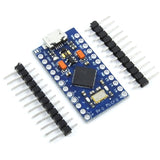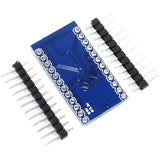ATmega32u4 PRO MICRO USB Leonardo (Arduino-Compatible)
FEATURES
-
Flux SKU:
CCBA100023 -
Length (mm):
33.3 -
Width (mm):
18.1 -
Height (mm):
4.1 -
Suitable (Noted projects):
Simulated Keyboard
Simulated Mouse
Virtual serial/COM port -
Form Factor:
PRO MICRO -
Brand:
Unbranded/Generic -
Main Colour:
Blue -
Country of Manufacture:
China -
MPN:
CCBA100023 -
UPC:
Does Not Apply -
Minimum Operating Temperature:
-40°C -
Maximum Operating Temperature:
85°C -
Number of Items:
1 -
Parts list:
1 PRO MICRO 5V 16MHz 32u4 blue
1 12 pcs M-M 2.54mm black pin header -
Pin Pitch:
2.54mm -
Logic Level Voltage:
5V -
USB Powered:
True -
Drive Current:
40mA per I/O pin
50mA per 3.3V pin -
Format:
USB -
Chipset MPN:
ATmega32U4 -
Clock Clock:
16MHz -
Flash Memory:
32KB -
SRAM Memory:
2.5KB -
EEPROM Memory:
1KB
DESCRIPTION
Arduino, describes a set of boards that provide easy to use hardware and software that allows people to construct interactive projects using all manner of electronics. No prior knowledge is required to begin, tutorials and small projects exist to help introduce you to the vast features and possibilities that the board series offers. Before you know it you will be embarking on large and ambitious projects without any limits.
Based on the ATmega32u4 chipset the Leonardo is next step up from the entry level Arduino-compatible boards. The board contains the ATmega32u4 chipset which features a built in USB 2.0. This allows the board to appear as a keyboard or mouse once connected to a PC. This opens up all manner of novel connections with a computer.
Offering a large range of input and outputs opens the board to be used in a large range of projects where the only limit is your imagination. The board can be connected up to all manner of sensors and switches as well as screens and LEDs, this allows for projects from automated watering systems to advanced robotics.
The board is programmed via the Arduino development software downloadable for FREE from their website. The software comes with a number of example codes to help introduce you to the system, we recommend trying the BLINK code example initially. If you require assistance please do not hesitate to contact us using one of the methods below.
The board is based on the Open Source Arduino project and follows the same exact specification. This may require a driver to be installed, however this is a standard driver that is distributed by Microsoft Windows Update, is not required on Linux and can be configured in MAC OS.











